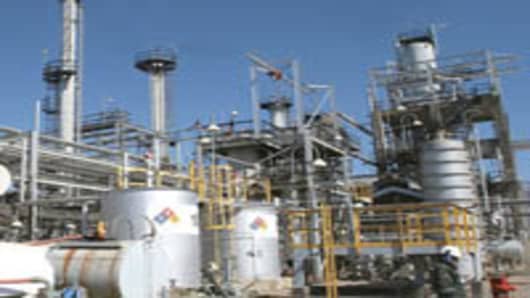Gasoline futures opened slightly lower Sunday evening as East Coast refineries got through Hurricane Irene relatively unscathed.
Nymex RBOB gasoline futures for October delivery, the most actively traded contract, were down $.02 at $2.76 per gallon, in electronic trading on CME Globex around 6:10 p.m ET.
The CME Group plans to begin open outcry trading of gasoline, oil, and other energy futures on schedule at the New York Mercantile Exchange trading floor in lower Manhattan at 9 a.m. ET on Monday.
The only refinery to shut down due to the storm has been ConocoPhillips' 238,000 barrel-per-day Bayway refinery in Linden, N.J., which also shut its terminal in Linden until it is safe to resume operations.
"Since these were controlled shutdowns—as opposed to when refineries suddenly lose power—a restart is expected to go smoothly," says OPIS energy analyst Tom Kloza.
East Coast oil refineries handle nearly 7 percent of the nation's refining capacity for gasoline, diesel fuel and other petroleum products—almost 1.4 million barrels per day.
Most of them cut processing rates ahead of the storm, some by as much as 25 percent. But refineries are expecting an orderly return to normal production levels.
A spokeswoman for Hess said its 70,000 barrel per day refinery in Port Reading, NJ "is back to normal rate."
"My sense is that spot gasoline prices and futures 'baked in' a little more disruptions than what actually occurred, so we may see some more selling in fuel prices ,” says Kloza.
Shipping disruptions may still delay oil deliveries to the East Coast—particularly the New York Harbor—which has restricted vessel traffic.
Most of the refinery terminals in the vicinity were also closed.
But the terminals have plenty of gasoline supplies—about three weeks worth—and storage capacity, which lessens the risk of shortages.
Many traders are now more focused on the sharp decline in gasoline demand.
Total U.S. gasoline demand is about 378 million gallons a day and one-third of that demand comes from the East Coast. But overall gasoline demand is down at least 2 to 3 percent from a year ago.
While many drivers filled up ahead of the storm, there is likely to be a net fall in demand and significant economic damage to the regional economy could cut demand further, says JP Morgan energy analyst Lawrence Eagles.
Retail gasoline prices could start to retreat as well, perhaps falling 5 to 7 cents, says Houston-based energy analyst Andy Lipow.
The national average is $3.61 a gallon today, up about 4 cents in the past week. But prices have declined about 10 cents over the past month.
Questions? Comments? Email us at marketinsider@cnbc.com




